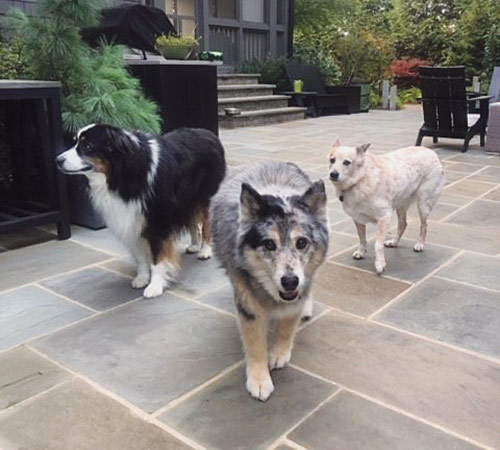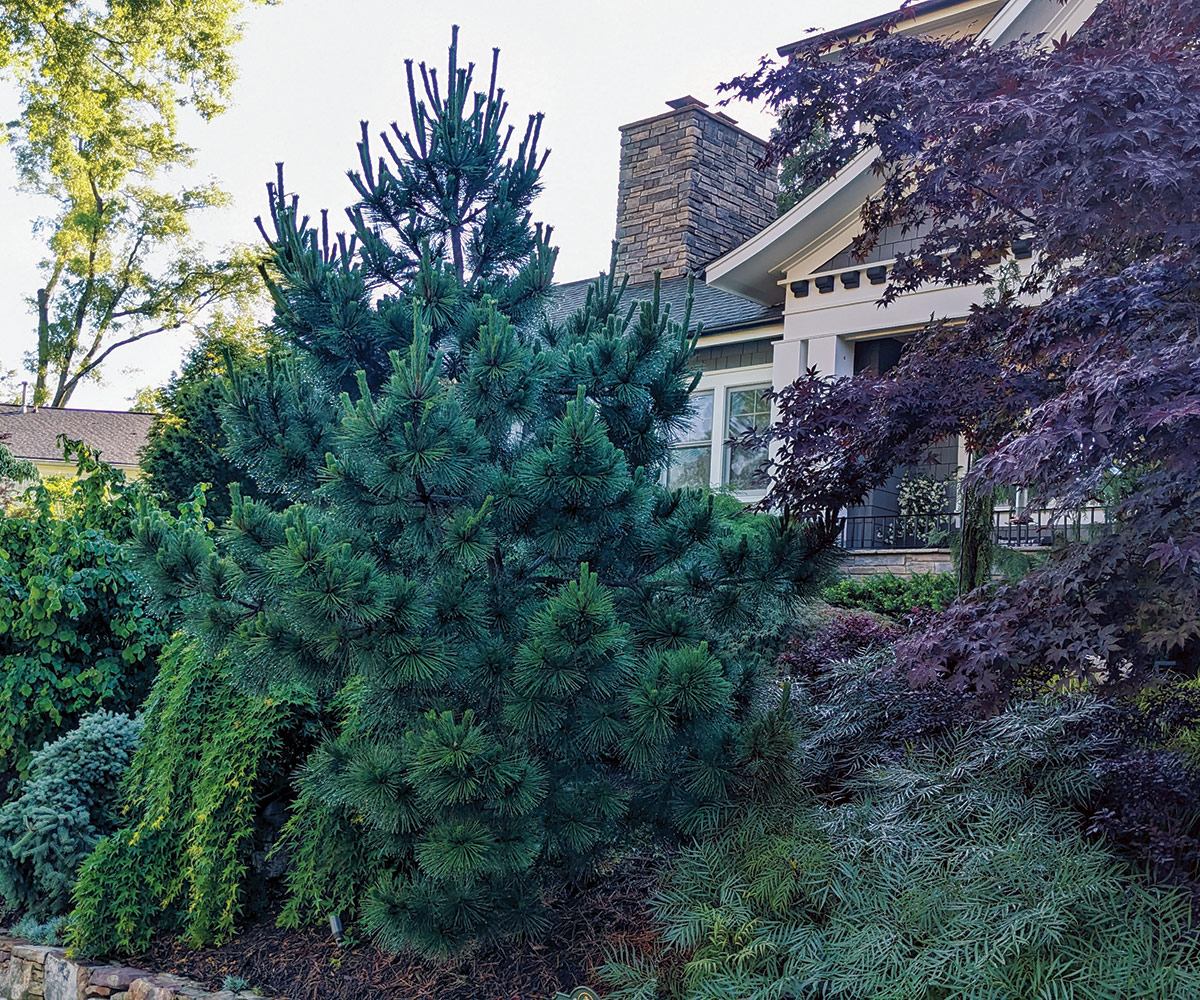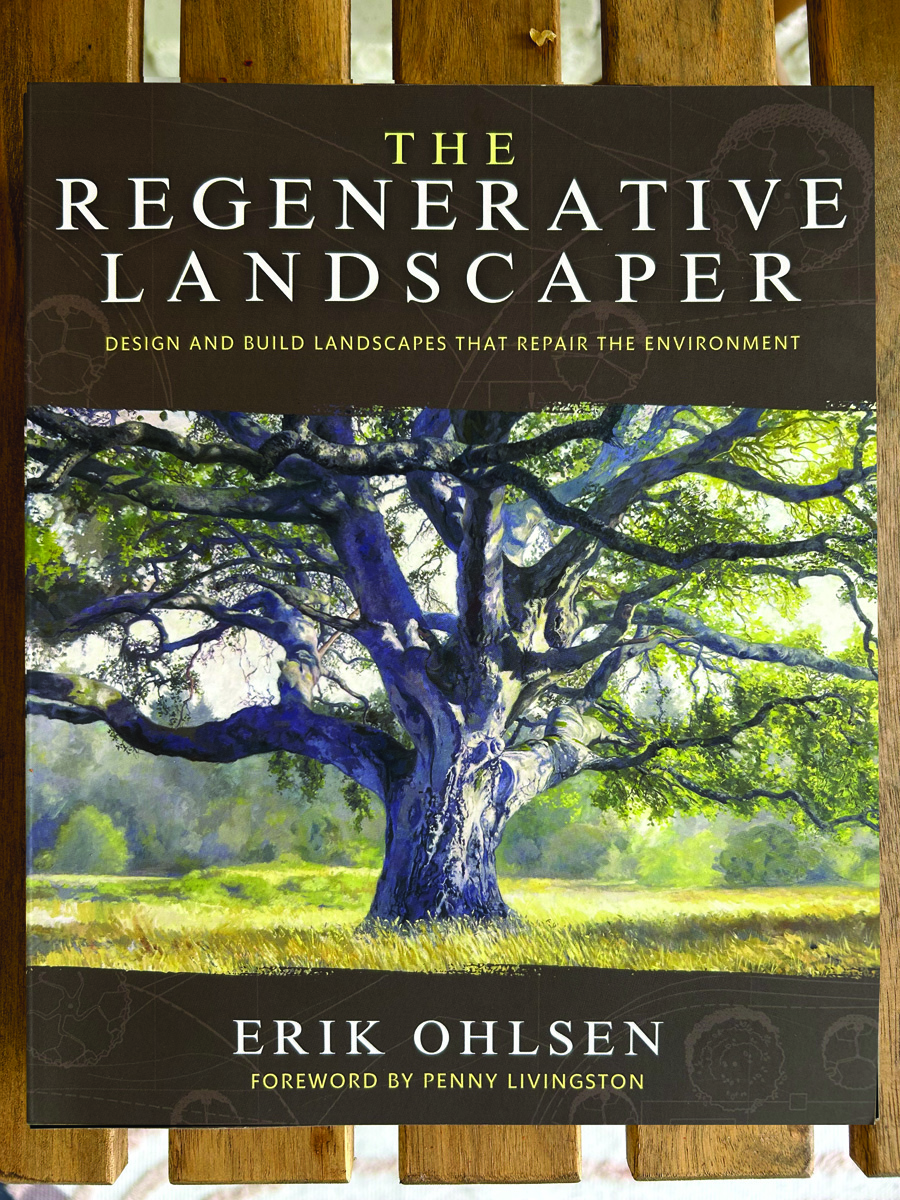
Have you ever dreamed of cultivating a garden full of plants that are climatically out of your reach? I certainly have. Despite living in humid, subtropical North Carolina, I’ve often longed to fill my beds with shade plants native to the cool maritime conditions of the Pacific Northwest. But gardeners are dreamers, so we do what we can to create the landscape we desire within the challenges of our reality. When I first met Rod and Melissa, I knew they were also gardening dreamers. The couple had recently moved from Los Angeles to Charlotte with two Australian shepherds, a cattle dog, and a desire to craft a lush, Seattle-like garden filled with Japanese maples, conifers, and ferns.
Their chosen house was infill construction, common in larger cities across the country. The lot is scarcely half an acre. Sitting lower than surrounding houses in the back, there was little privacy. The resulting fishbowl feeling was uncomfortable to the homeowners and their pups, whose previous West Coast residence backed up to a protected natural area. A local landscape architect was initially hired to tame the slopes with retaining walls, to install a bluestone terrace, and to plant evergreens that would eventually provide some much-needed privacy and softness to the hardscape. Turf was also planted, but the three boisterous dogs quickly turned the lawn into a muddy mess.
It was at this point that the homeowners reached out to me. They had seen photographs of my design work and felt that my “Pacific Northwest meets the Southeast” aesthetic meshed perfectly with their dream for the property. Thus began a 10-year working relationship that has encompassed several phases, turning an overexposed urban lot into a magical oasis filled with plenty of pet-friendly details.

Making a small space seem bigger for the entire family

At barely a half acre, this multifaceted garden has a lot going on despite its tiny footprint. The exaggeration of the longest sight lines helps elongate the space, while specific design details make this a garden filled with recreational opportunities (both human and canine).
- Patio
- Outdoor kitchen
- Horizontal privacy fence
- Pool
- Deep garden beds
- Side entry gate (with doggie window)
- Gravel paths
- Evergreen screen
- Ornamental spheres
- Emperor 1® Japanese maple
Strike a balance between abundant plantings and negative space

The backyard was the initial priority. This family had three active dogs, so a good amount of the garden footprint needed to be reserved for puppies to play. But indoor/outdoor pups covered in mud isn’t an ideal scenario. So instead of turf—which let’s face it, always looks a bit unkempt when you’ve got dogs—I lobbied to install wide gravel paths (photos, below). These obviously offered a way for people to move through the space, but they were also generous enough for the dogs to use as a playscape. The stone pathways provide a clean, crisp negative space to balance the densely planted, immersive garden beds. The owners wanted a lot of plant diversity, so without such wide, defined paths, the beds may have looked like a jumbled assortment. Although Melissa initially questioned the idea that dogs and gravel were a match made in heaven, she eventually agreed, and the concept ended up working perfectly. The gravel makes dog cleanup easy and gives the pups an area to frolic without causing damage to anything in the garden.

Next came the planting plan. Even though the gentle curves of the metal edging that contained the gravel paths introduced some yin to the existing yang, the 90° angles of the brick walls flanking the property lines needed softening. Additionally, the garden needed to be laid out in a way that kept the eye low and moving, rather than wandering upward toward the neighboring houses. The design also needed to curb any canine desire to spend time inside the garden beds. And we needed to embrace Rod’s directive to incorporate specific plants that would create a Pacific Northwest vibe. The beds were heavily planted with an immersive tapestry of color and texture. The thick plantings also deterred romping canines. Low-growing juniper cultivars that are tolerant of light shade, such as ‘All Gold’ and ‘Blue Pacific’ (Juniperus conferta ‘All Gold’ and ‘Blue Pacific’, Zones 6–9), were planted because their needled foliage makes for unpleasant dog bedding. Strategically placed small trees, such as Japanese maples (Acer palmatum cvs., Zones 5–9) and large woody shrubs, also limit the room for running. Dog owners will notice over time, however, that their pets generally return to the same areas to do their business and mark their territories. Such was the case in this garden. One patch of sedge (Carex cv., Zones 3–9) consistently died due to repeated exposure to dog urine, so we eventually left the area open and mulched it.

After the back garden was initially planted, the work moved out front. The first iteration involved sprucing up the foundation plantings and tackling the hillside that slopes toward the street. The homeowners wanted privacy from the noisy road, so some height was incorporated in a way that felt more interesting and inviting than austere and private. An existing Emperor 1® Japanese maple (A. palmatum ‘Wolff’, Zones 5–9) informed the plant palette, as did the black gutters and downspouts. I added several dusky-leaved plants to create drama and to pull the hue of the house’s architectural elements into the garden. That dark foliage was then juxtaposed with rhythmic masses of chartreuse ‘Everillo’ sedge (C. oshimensis ‘Everillo’, Zones 5–9) to add a dose of contrasting color (photo below right). Boulders were added to create a dialogue between the hillside bed and the lower stone wall. Finally, a peastone path runs along the uppermost portion of the bed and ends at a gate that separates the front and back gardens. The entry point even has a cutout near ground level so that the dogs can peer out.

Exaggerate long sight lines to give a small footprint depth
Long sight lines were imperative, in the front garden as well as in the back. Out front, we used multiple stonelike fiberglass spheres, larger on the entry landing, smaller at the axial termination point of the street-facing bed. We interspersed these orbs with ball-pruned and conical boxwoods (Buxus spp. and cvs., Zones 5–9) for juxtaposition and to add some playful interest. Encountering a larger sphere up close with smaller spheres in the distance exaggerates the perception of space, making a small area feel larger and longer.

In the back, the garden was run diagonally in relation to the house and brick walls, capitalizing on the longest sight line. Tree-form ninebarks (Physocarpus opulifolius cvs., Zones 3–7) were installed on each corner of the brick wall to create rhythm through the space. Meaningful repetition is how we subconsciously connect to a space, pulling the eye along in a certain pattern. If the eye is kept moving through the garden, the larger it is perceived to be.

While the main gravel paths emphasize the newly imagined long sight lines, they do curve around the corners of the home at either end of the backyard. Laying them out in this fashion employs another design trick to make the space feel larger: the mind of the viewer is challenged to imagine the spaces that could exist just out of sight. Adding curves also helps slow down the energetic pups, giving them a sort of cul-de-sac to turn around and head in the opposite direction, instead of hitting a full stop off a straightaway.
Thoughtful screening provides privacy and subtle containment

Most gardeners have discovered that gardens are not static but inevitably change over time, and this one is no exception. In the front, a large city-owned oak (Quercus cv., Zones 3–8) eventually succumbed to its age and was removed. This left the garden suddenly exposed to hot, intense afternoon sun. We took this change as an opportunity to plant lots of pollinator-friendly perennials, drawing more wildlife to the area. Adding more screening conifers to the surrounding area provided shelter and nesting sites for birds, and some of these additions even host harmless mites that are an important protein source for visiting hummingbirds (photos above and right).

The second big change that presented a design challenge was Melissa’s long-standing desire for a swimming pool and pavilion. The resulting construction meant removing a conifer garden that occupied the area under consideration. This addition also created an opportunity to reimagine the backyard privacy fence. The existing barrier was replaced with a horizontal-slat cedar fence that was stained black (photo below). The gaps between the boards bring a bit of airiness to the space while being tight enough to discourage neighborhood children from climbing the fence, an important consideration when a swimming pool is installed. The horizontal board arrangement keeps the eye low, as opposed to a more typical vertical design that pushes the eye upward, another trick to make a small space feel larger. Additionally, the black color causes it to recede, making the backyard feel roomier. It provides a dramatic backdrop for the planting scheme of dark green columnar yews (Taxus cv., Zones 4–7), white hydrangeas (Hydrangea paniculata cv., Zones 3–9), and chartreuse sedges (photo above). An important added benefit is that all of the fencing, walls, and subsequent plant screening keep the dogs within the property.

This garden will inevitably continue to evolve. Rod’s passion for plants necessitates making room for new additions and reimagining vignettes. But at its core it will remain an enchanted space for both two-legged and four-legged visitors that seems more private and larger than it actually is. Every time I visit, I’m amazed at the magic and tranquility that the garden offers.
Ways to make pets feel welcome
It seems like we often talk about ways to keep our beloved pets out of our garden spaces, but we seldom think about ways to welcome them in. Simple details can be found throughout this beautiful space that are specifically aimed at making the resident doggies happy. Incorporating these elements lets four-legged family members know where they are allowed to roam and helps them feel more at ease.
Designated open spaces
Whether it‘s a spot that gets constantly peed on or just an area that Fido likes to always lie in, keeping a few open spaces in your garden beds can help pets feel welcome and guide them to specific zones just for them (instead of squashing a prized perennial).
Peek-through windows
Many dogs are naturally curious about their surroundings, so enclosing them in a backyard without a window to the outside world can feel claustrophobic. A low opening in a fence or gate can help avoid destructive climbing and jumping by inquisitive pets.
Watering stations
Hydrated pets are healthy pets, so outdoor water bowls are a permanent fixture in this garden. An elevated holder helps keep blowing garden debris out of the water, while the placement next to the outdoor kitchen (and beside the beer fridge) always elicits smiles from visitors.
Jay Sifford is an award-winning garden designer residing in Charlotte, North Carolina.
Photos, except where noted: Danielle Sherry
Fine Gardening Recommended Products

The Regenerative Landscaper: Design and Build Landscapes That Repair the Environment
Fine Gardening receives a commission for items purchased through links on this site, including Amazon Associates and other affiliate advertising programs.

Berry & Bird Rabbiting Spade, Trenching Shovel
Fine Gardening receives a commission for items purchased through links on this site, including Amazon Associates and other affiliate advertising programs.



























Comments
Log in or create an account to post a comment.
Sign up Log in